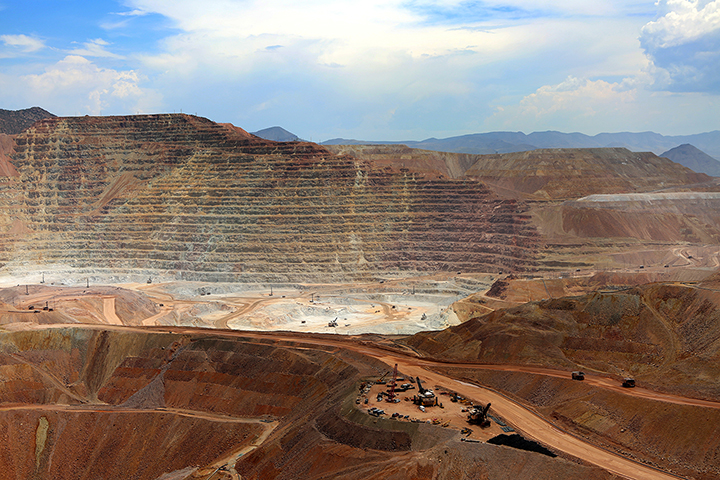Selecting the Discount Rate
Whose Interest is Being Valued?
ABSTRACT
A variety of methodologies exist for selecting a discount rate in appraising mineral interests, with there being no consensus regarding the appropriate one(s) to use. Notwithstanding differences in opinion regarding the methodology, it is important to understand that the interest being appraised is of primary importance in selecting the methodology or, ideally, the methodologies used. This paper examines two of the most common alternative mineral interests to be valued—value from the standpoint of a passive investor and value from the standpoint of the operator of the mineral estate—and discusses appropriate methodologies to be used in selecting discount rates for each.
INTRODUCTION
It is not uncommon for clients to need their mineral reserves appraised. If an interest in those reserves is controlled through ownership and the owner has leased the right to extract those reserves to an operating entity, then two distinct interests in the same reserves have been created—the leased fee estate and the leasehold estate. These two interests in the same reserves:
1. require different methodologies to be appraised;
2. can be valued simultaneously; and
3. can yield significantly different values.
The focus of this paper is to examine and explain why the appraisals of these two interests in the same reserves can require different methodologies for determining the appropriate discount rates needed. But first, an overview of why discount rates are needed in the first place is essential.
Traditionally, appraisers have used three approaches to develop value in an appraisal assignment—Cost Approach, Sales Comparison Approach, and Income Approach. Theoretically, each of these approaches is a method or technique based on factual data presumably extracted from the market. The appraiser then compiles the data for each approach in order to develop separate indications of market value. The indications of market value from each approach should then be reconciled, evaluated, and weighted to reach a final estimate of value. The appraiser must consider, but may not necessarily use, all three approaches. For a particular property or type of property, the value indication from one approach (or two) may be most significant.
In an appraisal of a mineral interest, the production status of the mineral is a key parameter in determining the appropriate method to use. If the underlying property does not have the requisite regulatory permits and is not currently being developed for production, then the Sales Comparison Approach is the most appropriate method, assuming comparable sales of similar mineral interests exist within a reasonable distance of the underlying property. However, if the subject property has all the necessary permits and is either in production or there is a reasonable expectation that production will commence within a determinable period of time, then the Income Approach is appropriate and normally used.
The Income Approach is an appraisal technique that capitalizes the anticipated income stream from the appraised assets. This approach is predicated on developing either cash flow or income projections that are then discounted for the time value of money and associated risk. According to the Dictionary of Real Estate Appraisal, Sixth Edition, the notion of the time value of money is “…the concept underlying compound interest which holds that $1 (or another unit of currency) received today is worth more than $1 (or another unit of currency) received in the future due to opportunity cost, inflation, and the certainty of payment.”
In economic evaluations and investment decisions concerning multiple alternative projects and limited available capital to invest, the project that generates the largest rate of return or return on investment—taking into account the time value of money—is normally selected if all other things are equal. Conversely, when an appraiser conducts a market appraisal, the forecast cash flows derived from the subject property are evaluated using a “market” discount rate to determine the value of the subject property acceptable to a willing buyer and a willing seller. It is important to note that market value does not represent what the value is to one particular buyer or seller—this is known as investment value and is not relevant to the issue of this paper.
A commonly accepted definition for discount rate is the rate used to convert a series of future cash flows to a single present value. However, more importantly for appraisal purposes, the discount rate represents the rate of return investors would require to be induced to purchase the rights to future income streams associated with a particular asset, thereby giving up liquidity, deferring consumption, and assuming the risks of investing. In the Uniform Standards of Professional Appraisal Practice–2018-2019 Edition, Advisory Opinion 33 speaks directly to discount rate selection as follows:
“Discount rates applied to cash flows and estimates of reversion should be derived from data and information in the real estate and capital markets. Surveys of investor opinion and yield indices are also useful in the rate selection process, but only when the type of and market for the asset being appraised is consistent with the type of and market for the asset typically acquired by the investors interviewed in the survey. Primary considerations used in the selection of rates are risk, inflation, and real rates of return.”
The discount rate is therefore market-derived and relates to the principal of substitution, whereas an investor would pay no more for a particular income stream than he would pay for an equal income stream with a similar element of risk.
There are various methodologies used to develop a discount rate, with no consensus about which is the most appropriate. However, regardless of the methodology selected the following key components must be examined and used appropriately in developing the discount rate no matter which interest is being appraised, each of which is discussed in the sections below:
• Inflation
• Tax
• Systematic risk
• Unsystematic risk
Inflation
Inflation is a core component in the concept of the time value of money, which is the basis for discounting in the first place. Whether the effects of inflation should be included or excluded in the development of the discount rate depends on how inflation is handled in the forecast of cash flows being evaluated. If the forecasts of income and expenses are prepared using inflation—commonly known as escalated, current, or nominal dollars—then an inflation component must be included in the development of the discount rate used. If the forecasts of income and expenses are prepared without using inflation—commonly known as unescalated, constant, or real dollars—then the appraiser must not include an inflation component in the discount rate selected. To do otherwise would have a significant impact on the value indication derived from the income approach.
Tax Considerations
Similar to inflation above, the discount rate must be selected using a methodology that either includes or excludes the tax effect based on whether or not the appraiser is evaluating before-tax cash flows or after-tax cash flows. If the appraiser is using yields from alternative investments or the results from a market survey, it must be determined whether or not those yields or results have already been adjusted for tax effects. As an illustration, it is common in the oil and gas industry to evaluate potential acquisitions on a pre-tax basis using before-tax discount rates, which are higher than after-tax discount rates. If an appraiser selected a rate developed from a market survey of those producers and then applied that rate to a forecast of after-tax cash flows, the appraiser would inappropriately penalize that indication of value and would likely undervalue the subject mineral estate.
Systematic Risk
Risk associated with an investment in a mineral interest associated with a particular industry or commodity and how it relates to an investment in the investment market as a whole is referred to as systematic risk. Systematic risk is the component of the discount rate that compensates the investor for the risk associated with an investment in the mineral estate as opposed to an investment in a more diversified market, such as the S&P 500. Systematic risk must be included in the discount rate selected by the appraiser in order to yield a market discount rate.
Unsystematic Risk
Unsystematic risk is the risk associated with a particular project such as legal, permitting, geologic, or company specific issues. The preferred method of accounting for unsystematic risk in an appraisal is to incorporate it into the forecast of cash flows, usually by using a sensitivity analysis to develop various indications of value based on “what-if” scenarios that have a reasonable probability of occurrence. However, some appraisers incorporate unsystematic risk directly into the discount rate. The danger here is that the forecast of cash flows must not also include any project-specific risk, otherwise the resulting indication of value will be inappropriately penalized. Also, unsystematic risk usually tends to decrease during the life of a project. Including unsystematic risk in the discount rate will carry that risk throughout the entire cash flow forecast.
LEASED FEE ESTATE
The leased fee estate is an ownership interest held by a landlord with the rights of use and occupancy conveyed by lease to others. The owner of the mineral interest comprising the leased fee estate is referred to as the lessor. The lessor is considered a passive investor because the control of the production of the mineral estate has already been granted to a lessee by the executed lease. In return for giving up this control the lessor receives royalties from the lessee, either in advance or as the mineral is produced, to compensate the lessor for the depletion of the asset. The lessor retains only whatever control was negotiated into the terms of the lease. This can range from retaining no control to retaining rights to cancel the lease if certain conditions are not met. Often the lease is structured so the lessee must pay minimum royalty payments if no production is occurring in order to induce the lessee to expedite production of the mineral. The lessor’s investment risk lies with the lack of control concerning the timing of receiving income, as opposed to the risk of the operator who must continue making financial investments in personnel, equipment, etc. until the reserves are exhausted.
To summarize, some characteristics of the leased fee estate are as follows:
• Passive investment
• Receive royalties
• Asset is depleting
• Lack of control beyond lease terms
• Risk is due to lack of control, not due to continued financial investment
In developing a discount rate to use in appraising the mineral interest in a leased fee estate, two methods are typically used:
• Opportunity cost of capital
• Market survey
Opportunity Cost of Capital
The opportunity cost of capital is the rate of return available in the market on other investments of comparable risk, liquidity and other characteristics to the asset being appraised. Incorporated in that rate is the cost of giving up the opportunity to do something else with the same money. For a passive investment like the leased fee estate, yields from alternative passive investments available on the market must be considered. The following list is comprised of possible alternative passive investments for a hypothetical appraisal of coal and natural gas interests encompassing a leased fee estate on a mineral property, but this list is certainly not all-inclusive.
• Treasury bonds with an appropriate maturity
• Portfolio of high-quality corporate bonds
• Portfolio of medium-quality corporate bonds
• High-yield corporate (junk) bonds
• Real estate investment trusts or similar
• Certain master limited partnerships
• Passive energy investments
As stated above, various factors must be evaluated and compared to the subject of the appraisal when evaluating yields from the above alternative investments. For instance, all items in the list above are completely liquid, unlike an investment in a mineral property.
Regarding the investments in the various bonds available, U.S. Treasury bonds are essentially risk-free investments and would not be appropriate to use as a comparable yield for the subject appraisal. High- and medium-quality corporate bonds would also not likely be comparable to the appraised interests regarding the risk of receiving future income. The risk of receiving future income in high-yield corporate bonds would be more comparable to the risk associated with the appraised interests.
An investor could gain exposure to the returns available from real estate by investing in a portfolio of entities, such as real estate investment trusts, companies investing in mortgage-backed securities, and companies that own and/or operate income-producing properties. Although an investment of this type would be a passive investment of a similar type to the appraised interests, these entities all have fairly large holding of properties located in diverse locations to minimize risk. An investment in a leased fee interest on a single mineral property would lose that portfolio effect and the yield from real estate investments would require adjustment before it could be considered comparable.
An investment in the units of master limited partnerships (“MLP”) that receive income from the ownership of mineral producing properties would be another alternative. Two such MLP’s are currently publicly traded and each receives income from coal and natural gas royalties. This alternative investment is the most comparable regarding the underlying investment in future coal and natural gas royalty income; however, both of these partnerships are highly diversified with numerous leases in various areas throughout the U.S. If the appraiser can adjust the yields from the MLP’s to compensate for the lack of a portfolio effect, then this alternative investment may be useful.
Another alternative is passive energy investments, which are also similar in nature to an investment in the appraised interests. Two potential passive energy investments are publicly traded partnerships with liquid propane assets and oil and gas royalty trusts. Both of these alternatives historically have higher average yields than the other alternatives listed above due to risks associated with markets and the corresponding swings in prices for many of the individual partnerships or trusts. Although their holdings may be more diversified, their forecasts of future income are not viewed as very stable. These may be useful for comparison purposes depending on other characteristics of the appraised interests.
The alternative investment yields discussed above are on a pre-tax basis, so the yield selected using any of the information above must be converted to an after-tax basis assuming forecasts of after-tax cash flows are being used. Additionally, the yields above also reflect the effects of inflation. If the forecast cash flows are in constant dollars, then the yield selected using any of the information above must be converted to an unescalated yield rate before selecting the discount rate to be used.
As mentioned above, the interests in these alternative investments are freely traded and thus completely liquid, which would not be the case for ownership of a mineral interest in a leased fee estate. One way to account for this is to adjust the discount rate. There are a number of ways in which such an adjustment to a discount rate can be established, including the addition of percentage points to the discount rate. The appraiser’s experience and evaluation of the nature of the appraised interests would determine the appropriate adjustment to make in this case. Typically, three to five percentage points is appropriate, however this could be higher depending on various circumstances such as the inability to freely assign the lessor’s interest in the lease without obtaining permission from the current lessee.
Market Survey
A market survey of discount rates used by other investors in the same type of and market for the mineral interest being appraised is likely the single best source of information for developing a discount rate to determine market value. Few (if any) rate surveys exist for many commodities and it can obviously be tough to get this proprietary information from competitors in the same area. This is a major benefit of utilizing a third-party appraiser—the anonymity of the respondents. Typically, these respondents are willing to discuss current discount rates with an appraiser as long as their companies’ identities remain confidential. Companies can then be referenced by using letter designations throughout the appraisal report.
For the mineral interest associated with a leased fee estate, the most appropriate interviewees would also own and have recently acquired leased fee estates comprised of the same type of mineral in the same market area. This requires a good determination of the “market” of likely buyers and it is very important to identify those entities that purchase leased fee estates instead of fee simple and leasehold estates.
When conducting the market survey, it is very important to obtain the following information:
• The method(s) their company currently uses to determine the value of leased fee estates comprising a similar mineral interest.
• The discount rate they are currently using.
• Are the discount rate and their acquisition analysis developed on an after-tax basis or on a before-tax basis?
• Do they use constant dollars or current dollars in their analysis?
• Do they include project specific risk in the discount rate or build it into the forecast of cash flows?
Responses from interviewees would likely provide a suitable market discount rate after adjusting their rates to account for their answers to the questions above.
LEASEHOLD ESTATE
The leasehold estate is the interest held by a tenant or renter through a lease conveying the rights of use and occupancy for a specified period of time under certain terms or conditions. The owner of the mineral interest comprising the leasehold estate is referred to as the lessee.
If the lessee is the operator of the mineral estate, then the lessee is considered an active investor because the control of the production of the mineral estate has been granted by the executed lease. In return for receiving this control the lessee pays the lessor royalties, either in advance or as the mineral is produced, to compensate the lessor for the depletion of the asset. The lessee receives only whatever control was negotiated into the terms of the lease. This can range from gaining complete control over timing, mine plans, drilling locations, and use of the surface to being required to obtain permission from the lessor for every change and decision regarding the property being leased. Often the lease is structured so the lessee must pay minimum royalty payments if no production is occurring in order to induce the lessee to expedite production of the mineral.
The lessee’s investment risk lies with the continuous financial investments in personnel, equipment, working capital, etc. associated with developing and producing the mineral estate, as opposed to the risk associated with the lack of control concerning the timing of receiving income. Usually, the lessee has the majority of control regarding production timing and subsequently the generation of income.
To summarize, some characteristics of the leasehold estate are as follows:
• Active investment
• Pay royalties
• Temporary (leased) asset is depleting
• Can control timing of production within terms of lease
• Risk of economic interest is associated with operation and market conditions, not the lack of control
Appraisers typically consider several methods in establishing discount rates to use in appraising the mineral interest in a leasehold estate, with the more common being a market survey of the industry and the weighted-average cost of capital approaches.
Weighted-Average Cost of Capital
For an active investment like the leasehold estate, the weighted-average cost of capital for companies in the same industry as the operator is one consideration. The weighted-average cost of capital varies from company to company and industry to industry because it is dependent upon differences in financial and operating risk. Three components are needed to compute the cost of capital:
• Cost of equity capital
• Cost of debt capital
• Appropriate capital structure
In computing the cost of equity capital, it is important to note that the cost of equity is consistent with particular levels of risk. These levels of risk must be quantified through one of several approaches available, such as the Capital Asset Pricing Model; however, it is not within the scope of this paper to explain the calculations and assumptions that would go into the Capital Asset Pricing Model. It is worth mentioning that the systematic risk associated with an operation leasing the mineral interests is accounted for by applying the appropriate beta value along with one or more risk premia when preparing the Capital Asset Pricing Model. The beta value is a measure of correlation between a particular investment or industry and the total equity market and can be obtained from various sources for a fee.
Additionally, to approximate the cost of debt capital several approaches are available. According to Shannon Pratt, in the publication Valuing Small Businesses and Professional Practices, Third Edition, if a company borrows, its actual cost of borrowing provides significant evidence of its cost of debt. Therefore, if any data exists regarding the cost of borrowing for the current operator or likely purchasers already in the market area, that information should be given considerable weight by the appraiser.
The capital structure is the basis for weighting the combined equity and debt costs. Data on the capital structure for various industries is available from several sources for a fee and is generally relied upon by an appraiser to determine the appropriate capital structure to use.
Once the three components are determined, the capital structure is applied to the cost of equity capital and the cost of debt capital to yield the weighted-average cost of capital for that entity. It may be necessary to develop the cost of capital for numerous companies within the same industry as the operator, or perhaps just one cost of capital for the industry as a whole, depending on the information available to the appraiser. After the various cost of capital calculations are completed, the appraiser must reconcile the results and determine the applicable discount rate to use in the appraisal.
Market Survey
As stated in the leased fee discussion above, a market survey of discount rates is likely the single best source of information for developing a discount rate to determine market value. For the mineral interest associated with a leasehold estate, the most appropriate interviewees would have recently acquired leasehold estates comprised of the same type of mineral in the same market area. This requires a good determination of the “market” of likely buyers and it is very important to identify those entities that purchase leasehold estates instead of fee simple and leased fee estates.
As with the market survey for the leased fee estate, when conducting the market survey for the leasehold estate, it is very important to obtain the following information:
• The method(s) their company currently uses to determine the value of leasehold estates comprised of similar mineral interests.
• The discount rate they are currently using.
• Are the discount rate and their acquisition analysis developed on an after-tax basis or on a before-tax basis?
• Do they use constant dollars or current dollars in their analysis?
• Do they include project specific risk in the discount rate or build it into the forecast of cash flows?
Responses to this survey would likely provide a suitable market discount rate after adjusting their rates to account for their answers to the questions above.
SUMMARY AND CONCLUSIONS
Although mineral reserves are often appraised for only one client’s interest, it is important to understand the characteristics of what is being appraised and apply the appropriate methodology in that appraisal. As such, it is necessary for an appraiser to include the Income Approach to value a mineral property that has all the required permits and is either in production or there exists a reasonable expectation that production will commence within a determinable period of time. Within the development of the Income Approach, one key component that is required is the discount rate.
Although there is no consensus on “the correct way” to determine the discount rate, the methodology selected must take into consideration the proper inclusion or exclusion of inflation, tax, and risk so that the discount rate correctly corresponds to the forecast income stream being evaluated. It is the evaluation of risk that guides the appraiser in selecting the methodology(s) that is (are) most appropriate to use, and the evaluations of inflation and tax that allow the appraiser to rationalize and/or adjust the results of the methodology(s) selected.
When the owner of mineral reserves leases the right to extract those reserves to an operating entity, then two distinct interests—the leased fee estate and the leasehold estate—in the same reserves are created. Each of these interests contains unique characteristics, such as investment risk, that require different methodologies for determining a discount rate.
The leased fee estate is a passive investment with little involvement required by the lessor to continue receiving an income stream. Most of this investor’s work was performed prior to obtaining an executed lease through exploration, investigation, and/or negotiations. Now the lessor will hopefully reap the benefits of the prior investment through the receipt of royalty payments from the operator. This is similar in nature to an investment in a security; however, different levels of risk in the assurance of receiving the income stream would require different rates of return to induce an investment. Finding other passive investments with similar levels of risk and analyzing their yields is a good method for developing a discount rate. Another good source is to survey other owners of comparable mineral properties—type and market—to determine what rate of return potential investors would require. If performed properly this has the potential of determining a truly “market” discount rate.
Conversely, the leasehold estate controlled by an operator is an active investment requiring continuous involvement by the operator to receive an income stream. Most of this investor’s work will be performed after signing a lease through development, production, processing and selling the mineral. An analysis of the cost of the capital required for this investment is one appropriate way to develop a discount rate. Developing a weighted-average cost of capital—incorporating both the cost of equity capital and the cost of debt capital—can generate the rate of return that a willing buyer might require to assume both the investment risk and operating risk, and therefore establish a discount rate for the appraisal. However, another good source, and possibly the best source if enough knowledgeable respondents can be found, is to survey other operators of comparable mineral properties to determine what discount rate they use in evaluating acquisitions of leasehold estates. Again, if performed properly this has the potential of determining the market’s discount rate.
It is clear from the discussion above that the operator and the landowner do not have the same financial and operating risks involved in their investment, nor would they require the same rates of return for those investments. It is the author’s conclusion that a mineral appraiser has an implied and expected responsibility to use different methodologies when developing those discount rates.






